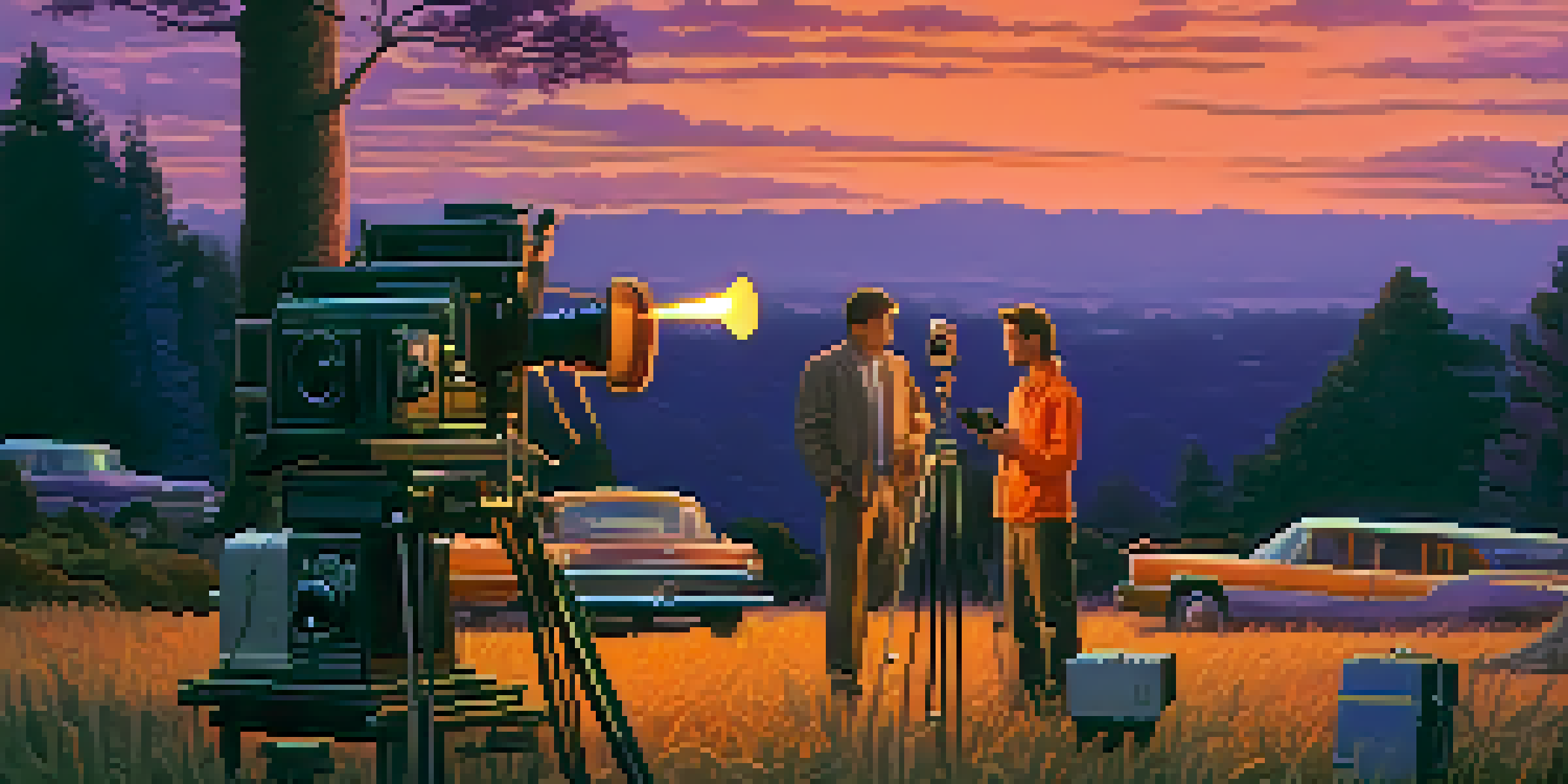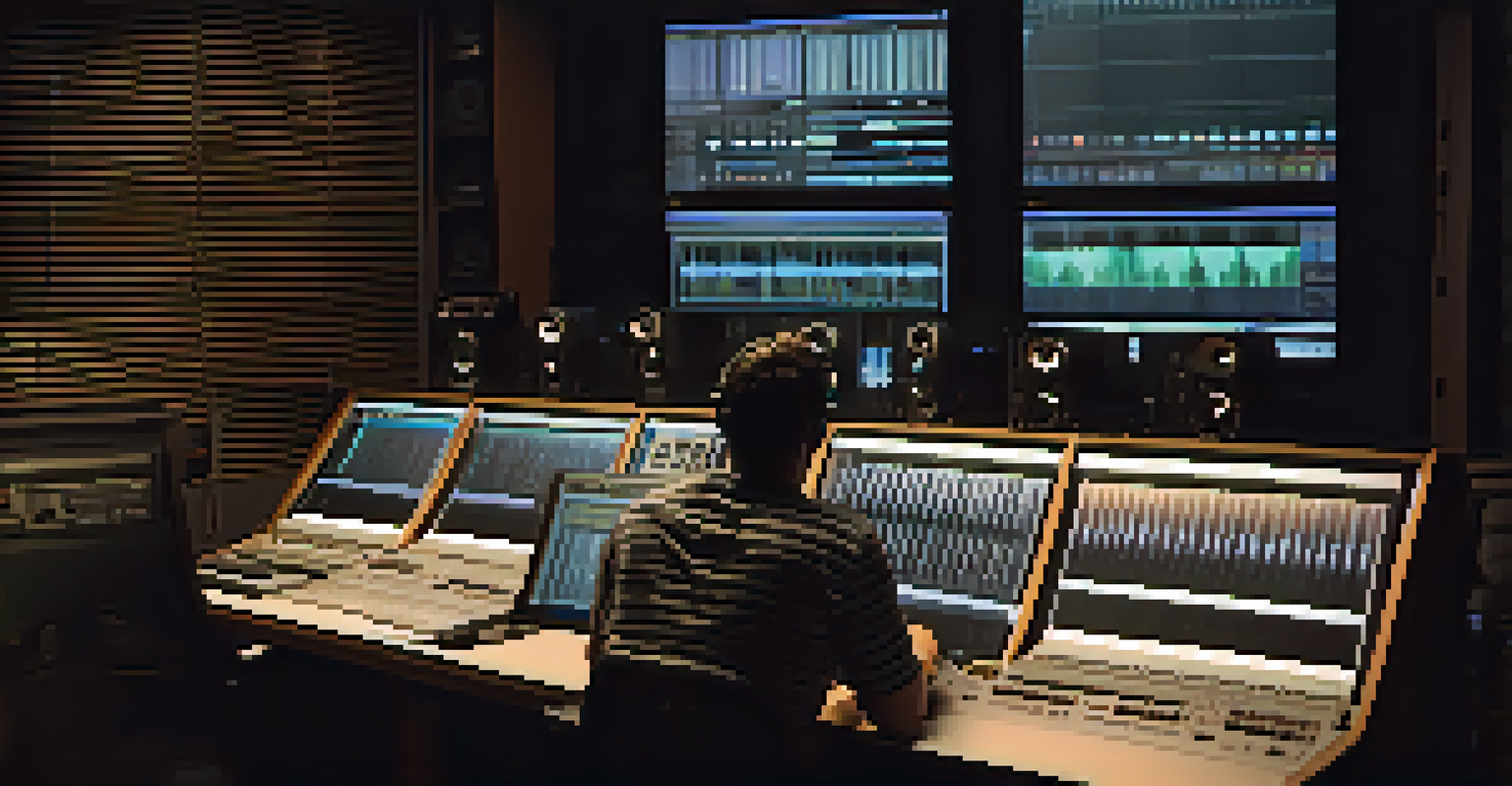The Impact of Directorial Choices on Film Sound Design

Understanding the Role of Sound Design in Film
Sound design is a crucial element of filmmaking that goes beyond just dialogue. It encompasses everything from sound effects to ambient noise and music, creating an immersive experience for viewers. When done right, it can evoke emotions, enhance storytelling, and transport audiences into the film's world.
Sound is a very powerful tool in the realm of storytelling, and it’s essential to a film’s overall impact.
Directors play a pivotal role in sound design, guiding how sound elements are integrated into their vision. Their choices can dictate the mood and tone of a scene, influencing how audiences perceive and react to the story. For instance, a director might opt for a minimalist soundscape in a dramatic moment to amplify tension or use a rich sound palette in a fantasy scene to create wonder.
Ultimately, sound design is not just a technical aspect of filmmaking; it’s an artistic one. The director’s vision helps shape how sound elements are utilized, making it essential to the film’s overall impact and audience engagement.
The Director's Vision: A Blueprint for Sound
Every film starts with a vision, and for directors, that vision includes sound. They often have a clear idea of how they want the audience to experience a scene, which directly informs sound design choices. For example, a director might envision a bustling city scene filled with life, leading to the inclusion of layered sounds like car horns and chatter.

Moreover, directors collaborate with sound designers to align their vision with the technical aspects of sound creation. This collaboration can lead to innovative soundscapes that push the boundaries of traditional filmmaking. Think about how directors like Christopher Nolan use sound to create tension and surprise in films like 'Dunkirk' or 'Inception'.
Sound Design Enhances Film Experience
Sound design is essential in filmmaking as it creates an immersive experience that evokes emotions and enhances storytelling.
Ultimately, the director's vision serves as a blueprint for sound design, guiding how sound is layered, mixed, and presented. This close partnership between directors and sound designers ensures that every sound element contributes to the film's narrative.
How Genre Influences Sound Design Decisions
Different film genres come with their own set of conventions, and directors often tailor sound design to fit these expectations. For instance, in horror films, a director might use unsettling sound effects and eerie silence to create suspense, while a romantic comedy might rely on upbeat music and lighthearted sound effects to enhance the mood.
The music is just the icing on the cake. The real cake is the sound design.
Directors are aware of these genre-specific conventions and use them to their advantage. By understanding what resonates with audiences, they can make sound choices that not only complement the visuals but also heighten emotional responses. A good example is the use of silence in thrillers, which can leave audiences on the edge of their seats.
Thus, genre plays a significant role in shaping sound design. A director's choices reflect their understanding of these conventions, ultimately guiding how sound enhances the storytelling.
Symbolism: Sound as a Storytelling Tool
Directorial choices often involve using sound symbolically to convey deeper meanings in a film. For instance, a specific sound might be associated with a character or theme, reinforcing the narrative. A director like Tim Burton frequently employs whimsical sounds to reflect the eccentricity of his characters and settings.
This symbolic use of sound can create a richer viewing experience, as audiences can pick up on these cues and make connections within the story. Directors often encourage sound designers to think creatively, looking for unique ways to integrate sounds that resonate with the film's themes. It’s a powerful method of storytelling that transcends dialogue.
Directors Shape Sound Choices
Directors play a crucial role in guiding sound design, collaborating with sound designers to realize their vision for the film.
As a result, sound becomes not just a backdrop but an integral part of the narrative fabric. Directors who embrace sound symbolism allow for a more immersive experience, inviting viewers to engage with the film on multiple levels.
The Impact of Silence in Film Sound Design
Silence can be just as powerful as sound in film, and directors often use it strategically to heighten impact. A well-timed moment of silence can create tension, evoke emotions, or lead to dramatic revelations. Think of a scene where a character processes shocking news; the absence of sound can amplify their internal struggle.
Directors understand the value of silence and often collaborate with sound designers to create these pivotal moments. By carefully placing silence within the sound design, they can manipulate the audience's emotional response, leading to a more engaging experience. This technique can be seen in films like 'A Quiet Place,' where silence is integral to the story.
In summary, silence is a tool that directors wield with intention. Their choices regarding when and how to incorporate silence can transform a scene, making it memorable and impactful.
Collaboration: Directors and Sound Designers Unite
The relationship between directors and sound designers is one of collaboration and mutual respect. Directors often rely on sound designers to bring their vision to life, yet they also provide creative direction throughout the process. This teamwork is essential for crafting a cohesive soundscape that enhances the film's narrative.
For example, during the pre-production phase, directors and sound designers might discuss themes, emotions, and specific sound elements that will be pivotal for certain scenes. This early collaboration sets the tone for how sound will be integrated into the film, ensuring that both visual and auditory elements work in harmony.
Silence is a Powerful Tool
Strategic use of silence in film can heighten tension and emotional impact, making it a vital element in sound design.
In essence, the collaboration between directors and sound designers is a dance of creativity. By working closely together, they can produce a sound design that not only complements the visuals but also elevates the entire film experience.
Case Studies: Directors Who Excel in Sound Design Choices
Examining specific directors can provide insight into how sound design choices shape their films. Directors like Quentin Tarantino are known for their meticulous attention to sound, using music and sound effects to enhance storytelling. His films often feature eclectic soundtracks that set the mood and deepen character development.
Another notable example is David Lynch, whose films frequently feature unconventional sound design. Lynch utilizes sound to create unsettling atmospheres, enhancing the surreal nature of his storytelling. His choice of sound can evoke feelings of discomfort and intrigue, captivating the audience.

These case studies highlight how directors can excel in sound design, leaving a lasting impact on viewers. By analyzing their approaches, we can appreciate the intricate relationship between directorial choices and the art of sound design in film.